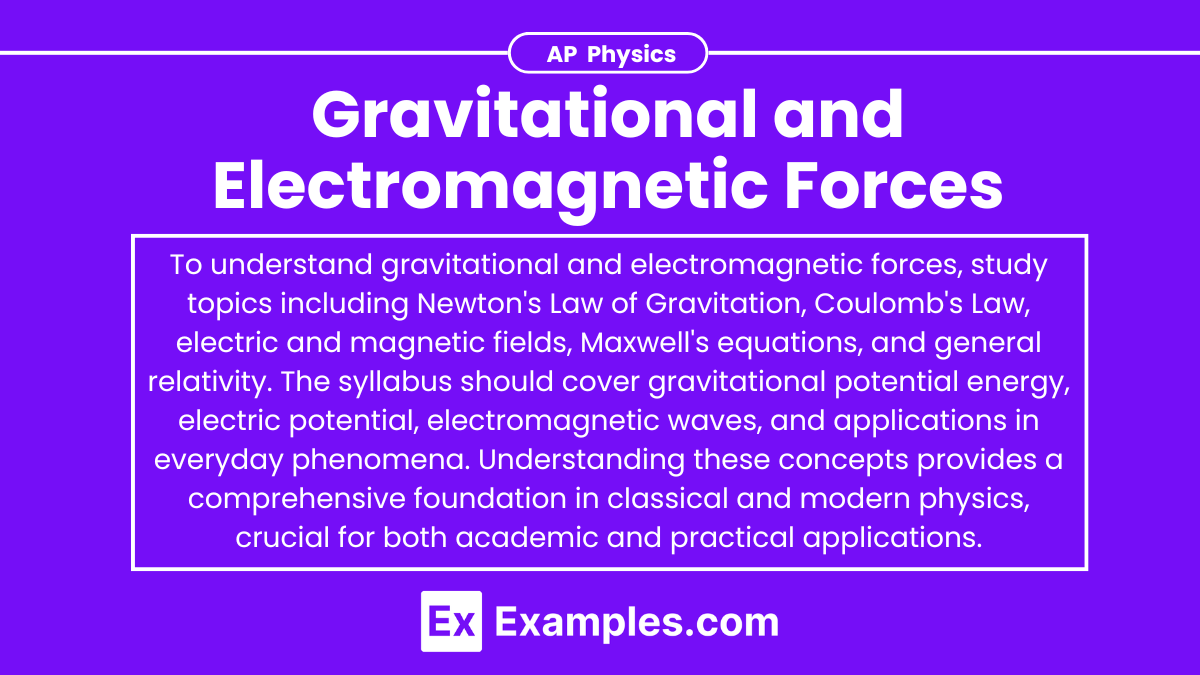Understanding gravitational and electromagnetic forces is crucial for mastering the concepts of forces and fields in the AP Physics exam. These fundamental forces govern interactions between masses and charges, respectively. Below are detailed notes along with five examples to help you achieve a high score on your AP Physics exam.
Learning Objectives
In studying gravitational and electromagnetic forces for the AP Physics exam, you should understand the nature and properties of these fundamental forces, their similarities and differences, and how they govern the motion of objects. Learn to apply Newton’s Law of Universal Gravitation and Coulomb’s Law to calculate the forces, analyze electric and gravitational fields, and solve problems involving potential energy and work. Additionally, grasp the principles of superposition and the role of these forces in planetary motion and electromagnetic interactions.
Gravitational Forces
Newton’s Law of Universal Gravitation
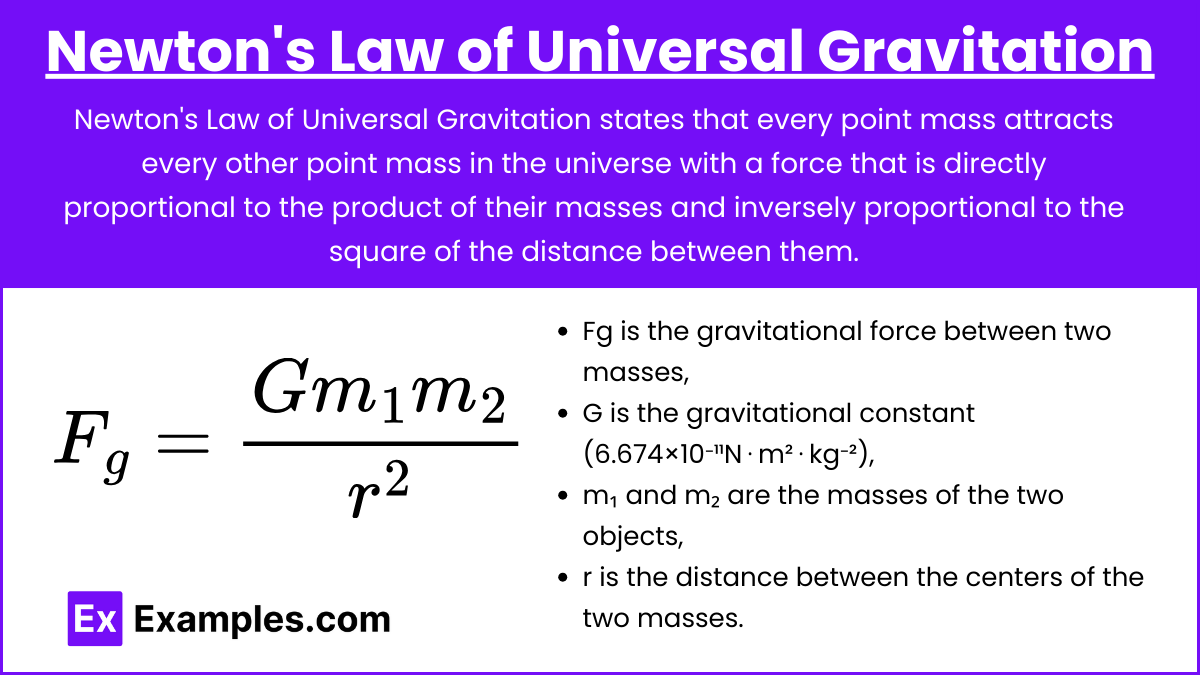
Definition: Newton’s Law of Universal Gravitation states that every point mass attracts every other point mass in the universe with a force that is directly proportional to the product of their masses and inversely proportional to the square of the distance between them.
Formula:
![]()
where:
- Fg is the gravitational force between two masses,
- G is the gravitational constant (6.674×10⁻¹¹ N⋅m²⋅kg⁻²6.674),
- m₁ and m₂ are the masses of the two objects,
- r is the distance between the centers of the two masses.
Key Points:
- Gravitational force is always attractive.
- It acts along the line joining the centers of the two masses.
- It is a central force, depending only on the distance between the objects.
Gravitational Field
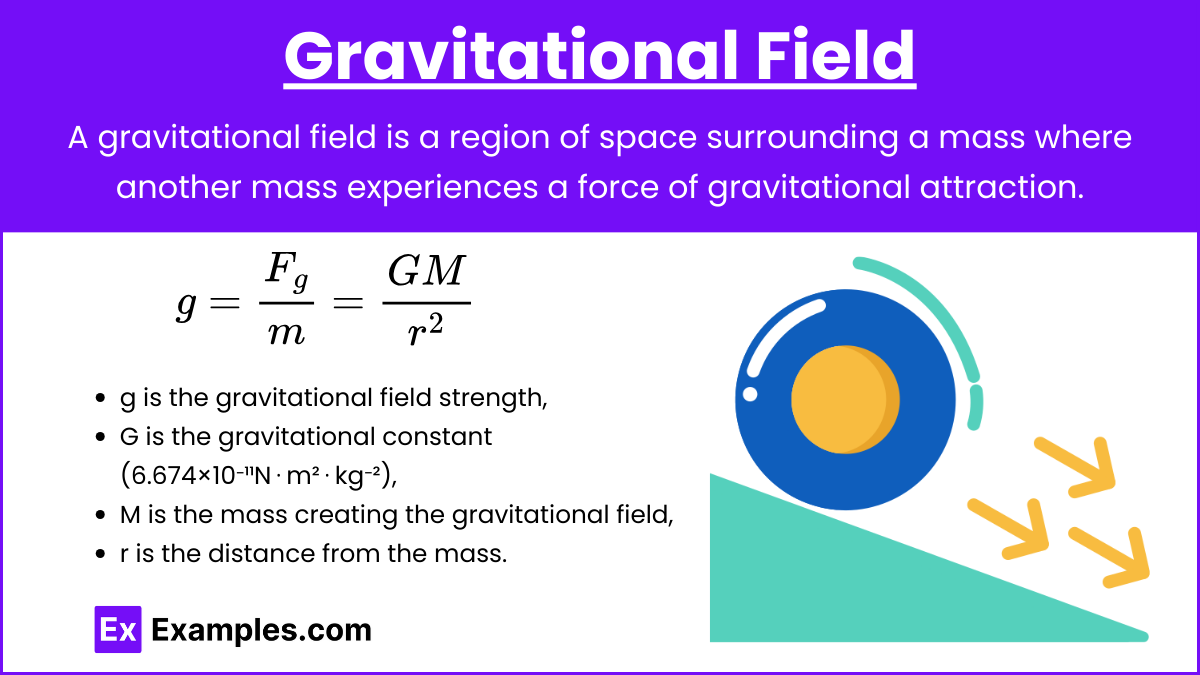
Definition: A gravitational field is a region of space surrounding a mass where another mass experiences a force of gravitational attraction.
Gravitational Field Strength:
![]()
where:
- g is the gravitational field strength,
- M is the mass creating the gravitational field,
- r is the distance from the mass.
Key Points:
- Gravitational field strength decreases with the square of the distance from the mass.
- It is a vector quantity, pointing towards the mass creating the field.
Electromagnetic Forces
Coulomb’s Law
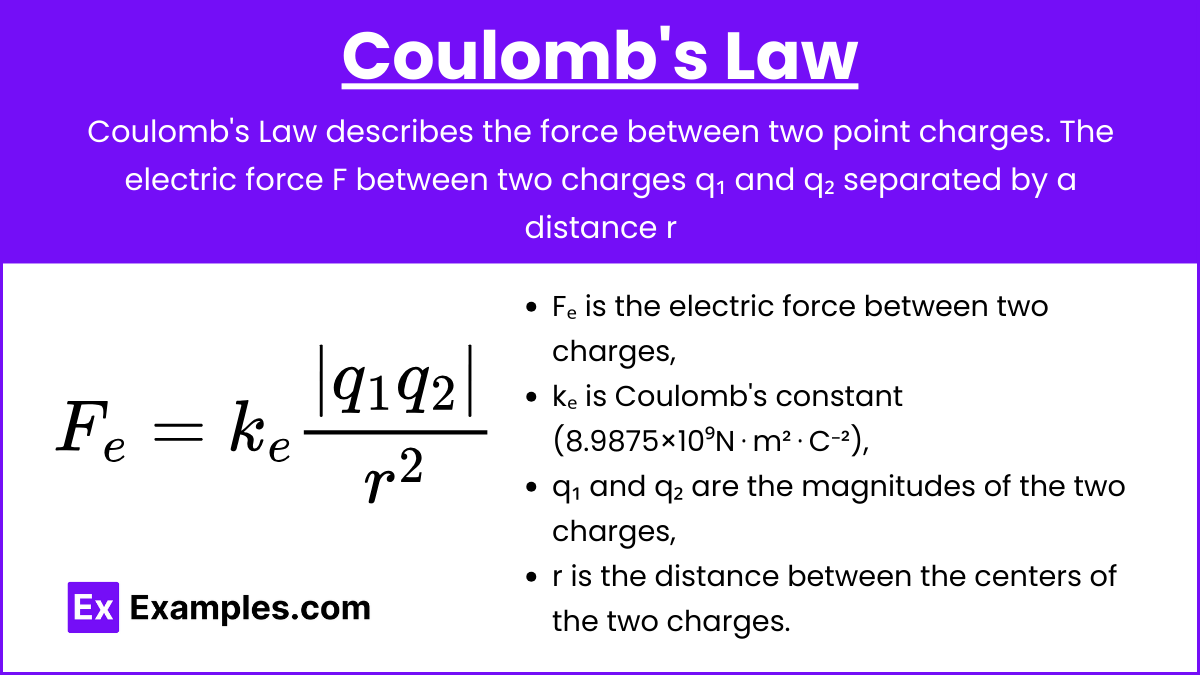
Definition: Coulomb’s Law states that the electric force between two point charges is directly proportional to the product of the magnitudes of the charges and inversely proportional to the square of the distance between them.
Formula:
![]()
where:
- Fe is the electric force between two charges,
- ke is Coulomb’s constant (8.9875×109 N⋅m²⋅C⁻²),
- q₁ and q₂ are the magnitudes of the two charges,
- r is the distance between the centers of the two charges.
Key Points:
- Electric force can be attractive (opposite charges) or repulsive (like charges).
- It acts along the line joining the centers of the two charges.
- It is a central force, depending only on the distance between the objects.
Electric Field
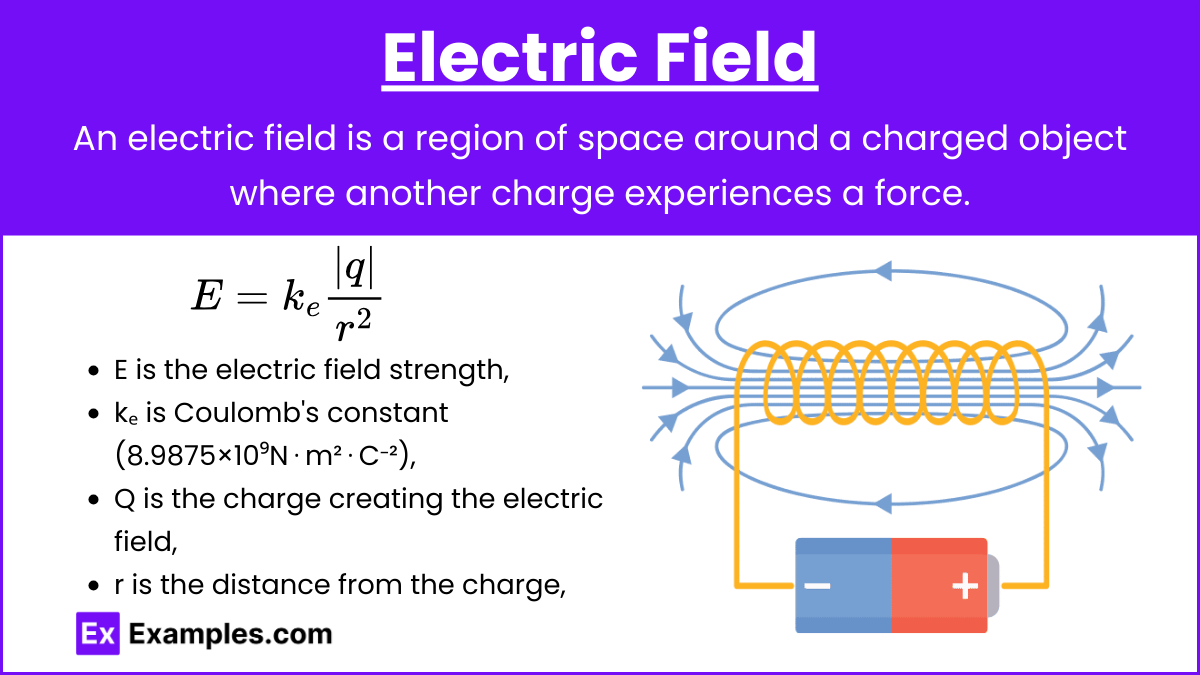
Definition: An electric field is a region of space around a charged object where another charge experiences a force.
Electric Field Strength:
![]()
where:
- E is the electric field strength,
- kₑ is Coulomb’s constant (8.9875×10⁹N⋅m²⋅C⁻²),
- Q is the charge creating the electric field,
- r is the distance from the charge.
Key Points:
- Electric field strength decreases with the square of the distance from the charge.
- It is a vector quantity, pointing away from positive charges and towards negative charges.
Example 1
Gravitational Force Between Two Masses
Scenario: Calculate the gravitational force between two 10 kg masses separated by a distance of 2 meters.
Solution:
![]()
![]()
![]()
![]()
Example 2
Electric Force Between Two Charges
Scenario: Calculate the electric force between two charges of +3μC and −3μC separated by a distance of 1 meter.
Solution:
![]()
![]()
![]()
![]()
Example 3
Gravitational Field Strength
Scenario: Calculate the gravitational field strength at the surface of a planet with mass 6×10²⁴kg and radius 6×10⁶m.
Solution:
![]()
![]()
![]()
![]()
Example 4
Electric Field Due to a Point Charge
Scenario: Calculate the electric field at a point 0.5 meters away from a +2μC charge.
Solution:
![]()
![]()
![]()
![]()
![]()
Example 5
Comparing Gravitational and Electric Forces
Scenario: Compare the gravitational and electric forces between a proton and an electron separated by a distance of 1×10⁻¹⁰m.
Solution: Gravitational Force:
![]()
![]()
![]()
![]()
Electric Force:
![]()
![]()
![]()
![]()
The electric force is vastly stronger than the gravitational force between a proton and an electron.
Practice Problems
Question 1
Two masses, m₁ = 5kg and m₂ = 10kg, are placed 2 meters apart. What is the gravitational force between them? (Use G=6.674×10⁻¹¹Nm²/kg²).
A) 1.67×10⁻⁹N
B) 8.34×10⁻¹⁰N
C) 3.34×10⁻¹⁰N
D) 6.67×10⁻¹¹N
Answer: B) 8.34×10−10N
Explanation:
The gravitational force F between two masses is given by Newton’s law of gravitation:
![]()
where:
- G = 6.674×10⁻¹¹Nm²/kg²
- m₁ = 5kg
- m₂ = 10kg
- r = 2m
Plug in the values:
![]()
![]()
![]()
![]()
Thus, the correct answer is 8.34×10⁻¹⁰N.
Question 2
An electron and a proton are separated by a distance of 1 meter. What is the magnitude of the electrostatic force between them? (Use k = 8.99×109Nm²/C² and e = 1.6×10⁻¹⁹C).
A) 2.30×10⁻²⁸N
B) 2.30×10⁻²⁰N
C) 1.15×10⁻²⁸N
D) 1.15×10⁻¹⁰N
Answer: B) 2.30×10⁻²⁰N
Explanation:
The electrostatic force F between two charges is given by Coulomb’s law:
![]()
where:
![]()
![]()
![]()
Plug in the values:
![]()
![]()
![]()
Thus, the correct answer is 2.30×10⁻²⁰N.
Question 3
Which of the following statements correctly describes a key difference between gravitational and electromagnetic forces?
A) Gravitational force can be either attractive or repulsive, while electromagnetic force is always attractive.
B) Gravitational force acts only on masses, while electromagnetic force acts only on charges.
C) Gravitational force is much stronger than electromagnetic force.
D) Gravitational force is always attractive, while electromagnetic force can be either attractive or repulsive.
Answer: D) Gravitational force is always attractive, while electromagnetic force can be either attractive or repulsive.
Explanation:
The gravitational force is always attractive, meaning it always pulls masses toward each other. It acts on any objects with mass. On the other hand, the electromagnetic force can be either attractive or repulsive depending on the charges involved; like charges repel each other, while opposite charges attract each other. This fundamental difference is crucial in distinguishing between the two forces.
Thus, the correct answer is that gravitational force is always attractive, while electromagnetic force can be either attractive or repulsive.

